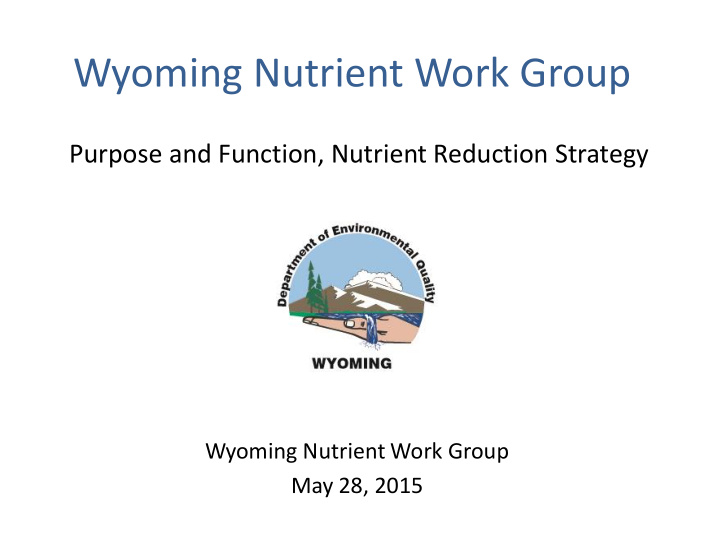



Wyoming Nutrient Work Group Purpose and Function, Nutrient Reduction Strategy Wyoming Nutrient Work Group May 28, 2015
Outline • Background on Nutrient Pollution • Nutrient Reduction Strategy • Stakeholder Group
Nutrient Pollution History 1996: In National Water Quality Inventory Report to Congress, EPA reported that nutrients were among the leading causes of water quality impairments in the U.S. Streams and Rivers Lakes and Reservoirs http://water.epa.gov/lawsregs/guida nce/cwa/305b/96report_index.cfm
Nutrient Pollution History 1997: EPA initiated Clean Water Act Plan (CWAP) to address excess nutrients in the nation’s surface waters. CWAP included development of numeric criteria as a component. Due to the complexity and variability in nutrient/response relationships, most states historically used narrative standards to protect designated uses from nutrient pollution (i.e., waters shall be free from)
Numeric Nutrient Criteria Numeric criteria for total nitrogen and total phosphorus and response parameters (e.g., chlorophyll) are expected to more effectively protect designated uses from nutrient pollution because: Do not require a site-specific analysis for each action Can be incorporated into discharge permits Can be used to assess waters for impairment Can be used to develop Total Maximum Daily Loads (TMDLs) Can be used to facilitate watershed protection and restoration
Nutrient Pollution History 2015 April 2015: http://iaspub.epa.gov/waters10/attains_nation_cy.control#status_of_data
Nutrient Criteria Development Plan
National Status of Nutrient Criteria April 2015
2011 EPA Framework Memo • Outlines key elements/building blocks of programs effective in addressing nutrient pollution • Promotes conversation among states and stakeholders on how best to proceed to achieve near term and long- term reductions in nitrogen and phosphorus pollution • Encourages collaborative approach between federal, state, local partners and other stakeholders
2011 EPA Framework Memo • Results oriented: build from existing state work, but accelerate progress and demonstrate results • Gives states flexibility to achieve near-term reductions while working on numeric criteria • Numeric criteria for a category of waters by 2016
Nutrient Reduction Strategy 1. Prioritize 8. Numeric watersheds for nutrient criteria N & P load work plan and reductions schedule 2. Set load 7. Annual reduction reporting goals NUTRIENT REDUCTION STRATEGY 3. Ensure 6. Measure effective point and verify source permits reductions 4. Identify 5. Identify how the effective practices state will reduce to reduce nutrient nutrient pollution pollution from from stormwater agricultural areas and septics
What Is EPA Asking Us to Do? • 2 Nutrient Related Performance Partnership Agreement (PPA) Commitments for FY15 (Oct. 1, 2014 – Sept. 30, 2015 ) • PPA outlines state commitments to achieve public health and water quality goals for federally-delegated environmental programs (e.g., Clean Air Act, Clean Water Act) • Maintain delegated authority of Clean Water Act
FY15 PPA Commitments • # of States That Have Adopted Numeric Nutrient Criteria: Nitrogen and Phosphorus for Lakes/Reservoirs and Rivers/Streams In FY13, we updated nutrient criteria database and developed a plan to fill data gaps in lakes/reservoir dataset In FY13, FY14 we conducted monitoring specifically for development of numeric nutrient criteria In FY15, we will collect additional data for numeric nutrient criteria Revising Nutrient Criteria Development Plan (mostly timeframes)
FY15 PPA Commitments • # States Making Progress Toward Reducing Nitrogen and Phosphorus Pollution on Watershed Basis and Establishing Nutrient Reduction Targets, and Continuing to Make Progress, with Performance Milestone Information, Towards Adoption of Numeric Nutrient Criteria for at least one class of water by 2016. Measure Tracked With Three Concepts: 1) Priority Setting 2) Setting Nutrient Reduction Targets in Each Targeted/Priority Sub-Watershed 3) Developing Nutrient Criteria.
FY15 PPA Commitments To date, have identified 303(d) Listed waters with suspected/known nutrient impairments for nutrient reduction - Gillette Fishing Lake (total phosphorus) - Belle Fourche River (ammonia) - Hams Fork (pH impairment below WWTP) - Wyoming established a Nutrient Work Group to assist state in prioritizing watersheds and identifying additional nutrient reduction targets.
Nutrient Work Group • Help DEQ address nutrient pollution in Wyoming through development and implementation of nutrient reduction strategy and development and implementation of numeric nutrient criteria Reduction Strategy: Evaluate elements, develop plan, assist in implementation of plan Criteria Development: prioritize waters for criteria development evaluate approaches to criteria development how to incorporate into standards expectations/off-ramps for wastewater facilities assessment methods for nutrient impairments
Nutrient Work Group • Entities impacted by and interested in nutrients in Wyoming Agriculture Wastewater Representatives Business Mechanical Plants Conservation Districts Lagoons Environmental Groups Rural Water Industry (Mining, Oil and Gas) Drinking Water Local Governments Facilities that Use Surface Water Technical Experts EPA Land and Resource Management DEQ (Watershed, Water/Wastewater, WYPDES) Governor’s Office
Nutrient Reduction Strategy FEEDBACK: Facilitator for development of nutrient reduction strategy? EPA can provide a contractor to assist the state in development of a nutrient reduction strategy or any of the components of a nutrient reduction strategy. Approximately 16 states have utilized this contractor for assistance in developing components of a nutrient reduction strategy Funding has ranged from $20,000 to $57,000; some states have had multiple contracts/projects
Questions? Lindsay Patterson Wyoming Surface Water Quality Standards Lindsay.Patterson@wyo.gov 307-777-7079
Nutrient Criteria Development Plan Plan Components, Updates Wyoming Nutrient Work Group May 28, 2015
Nutrient Criteria Development Plan
Nutrient Criteria Development Plan
Nutrient Criteria Development Plan
Nutrient Criteria Development Plan
Nutrient Criteria Development Plan • Proposed Changes: Update approaches (add modeling, dose-response studies) Update timeframes (added flexibility) Increase flexibility in approaches for deriving criteria – multiple lines of evidence • Send revised plan to work group for review • Discuss plan and obtain feedback at next meeting • Finalize updates to plan
Questions? Lindsay Patterson Wyoming Surface Water Quality Standards Lindsay.Patterson@wyo.gov 307-777-7079
Recommend
More recommend